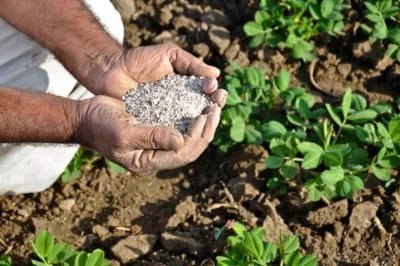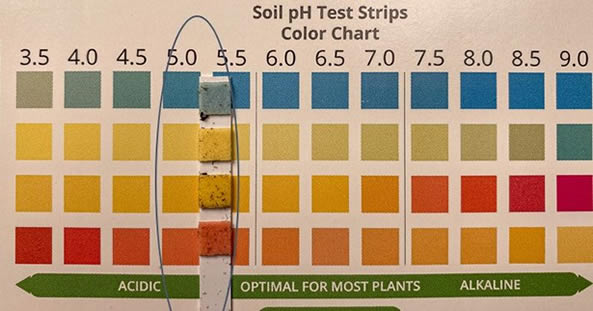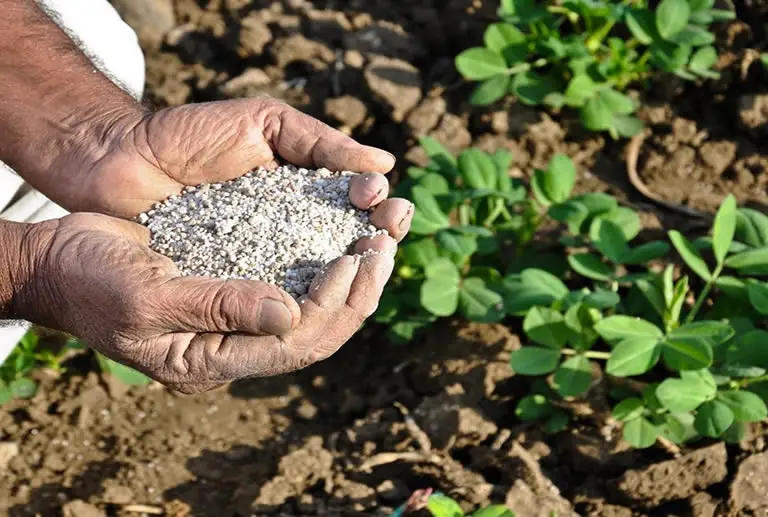There are are so many additives that are recommended to use in our gardens these days it can be difficult to know which ones are beneficial to our specific gardens and which ones the garden doesn’t really need. Sulfur is one such addition that is often mentioned but seldom discussed.
Table of Contents
Is Sulfur Good For The Garden?
Sulfur is very good for your garden. Micro-organisms in the soil convert sulfur to sulfuric acid which helps to lower the soil’s pH levels.
Sulfur is also an essential mineral needed by plants as it plays an important role in the formation of essential enzymes and plant proteins.

Before you start applying sulfur to your garden be aware that the sulfur quantities must be correct though as too little leads to poor plant growth but too much can cause other problems.
In this article I will give all the information you need to know so you can decide if your garden could benefit from sulfur.
Why your yard may be in dire need of some garden sulfur
Sulfur is an essential nutrient for the garden.
When your garden plants are deficient in sulfur they will lack vitality and will often grow to be limp or spindly and will likely have yellow-tinted unhealthy looking leaves.
Blooming plants deficient in sulfur will rarely produce any flowers and veg or fruit plants will only produce inferior crops or will have no crop production at all.
Sulfur is vital for a healthy garden.
In garden soil sulfur has a dual effect. These effects are:
- A lowering of the soil pH.
- The growing of healthy plant tissue.
Let’s take a look at these two very important roles that sulfur plays in your garden.
The many benefits of using garden sulfur in your yard
Garden sulfur, often sold in a in a 3-in-1 product that includes magnesium and potassium, is great for all types of plants and vegetables.
Let’s take a look at why adding sulfur to your garden can give your entire yard a boost and bring your plants to life.
You can use sulfur to lower the soil pH value
Sulfur is not just good for plants it is also very good for the garden soil they grow in.
Micro-organisms, i.e. soil bacteria, convert sulfur into sulfuric acid and this process then lowers the soil’s pH levels.
You are probably already aware of the importance that soil pH plays in plant cultivation but in case you are not I will quickly cover the main points.
Soil pH greatly affects the amount of nutrients that are soluble in water.
It is through water that plant roots take up the nutrients from the soil to create healthy plants.
So high pH levels in the soil will disrupt this process by stopping the nutrients from dissolving in the water and thus reaching the plants.
Sulfur is a great way to lower pH values in garden soil.
By using sulfur it is possible to lower soil pH so that nutrients can properly dissolve in soil water and be take up by plant roots.
All plants benefit from sulfur
Obviously when the pH of soil is at healthy levels this will mean healthy plant growth.
But sulfur is also plays an important role in plant growth independent of pH levels.
Garden sulfur is good for plants and vegetables.
Sulfur is an important mineral in and of itself that helps plants in the formation of both the essential enzymes and critical plant proteins that are needed to form healthy plant tissue.
The correct amount of sulfur in the soil is needed for the growth of healthy plant tissue.
Now that you understanding the two important roles that sulfur plays in the garden it is time to understand just how much sulfur your garden actually needs.
Too much sulfur in the soil is a bad as too little
As you’ve seen in the information above, sulfur is an important mineral for the garden and an important regulator of pH levels.
Not only does it help to lower soil pH but it also plays a vital role in the formation of plant proteins needed for the growth and development of healthy plants.
However, you must be careful with the amount of sulfur you add to your garden.
More is not necessarily better!
Bear in mind that too much sulfur is just as bad as too little.
Although having too little sulfur in the garden can restrict plant growth and lead to unhealthy crops, adding too much sulfur to your garden can have a similar effect.
Just as too little sulfur in the soil can mean high soil pH which restricts the uptake of certain nutrients via soil water, too much sulfur in the soil can restrict the uptake of other minerals.
The uptake of nitrogen, for example, will be greatly effected by high sulfur levels in soil.

Lack of nitrogen will lead to poor plant growth.
Leaves of plants that are nitrogen deficient will tend to be a pale green or yellowish color because they are unable to make sufficient chlorophyll.
A lack of nitrogen will generally result in a poor quality plant.
How to apply sulfur to the garden
Below are the steps you should follow to ensure you apply the correct quantity of sulfur to your garden.
Below I have given two sets of instructions. These are for:
- Applying sulfur to lower soil pH in uncultivated ground.
- Applying sulfur to combat nutrient deficiency in plants.
How to add sulfur to soil to lower pH levels & how much you need to use
If you are using sulfur to reduce the pH levels in your garden soil follow the steps below.
The following steps are applicable to soil in an unplanted garden.
If you have plants in the garden already then follow the steps in the section below this one. pay close attention to how much sulfur to add to the soil as you don’t want to overdo it.
Steps to add sulfur to soil to lower soil pH:
- Start by testing the pH level of your soil. You are best using a very reliable kit like the one Hydroponics Organic make, which is available from Home Depot. Although that kit includes solutions for both raising and lowering pH levels you may find that you want to use a separate sulfur solution instead. Of course you may prefer a good digital tester
instead if you are prepared to pay an extra few bucks as this will also test the nutrient levels in the soil.
- Be sure to test several samples of soil from different areas. Look for the acidity or alkalinity rating, i.e the pH level. The pH level of your soil will determine how much sulfur you need to add and instructions will be included with a good sulfur fertilizer. There are a wide range of products available
to suit all pockets and all garden sizes.
- You will want to add enough sulfur to lower your soil pH level to about 6.5 – 7.0 so that it is almost neutral and only slightly acidic. Most garden plants and vegetables will grow happily at this pH level.
- Depending on which type of product you are using, liquid or powdered, pour or rake the sulfur as evenly as you can over the area to be treated.
- Take a shovel, spade, or trowel (if you are treating a small area) and turn the soil to a depth of a few inches ensuring the sulfur mixes thoroughly with the soil. If there are large clumps of soil left after this process you can rake the soil to break them up.
- Allow the soil to sit unattended for at least 10 days, but preferably 3 – 4 weeks, before planting or seeding. Being patient gives the micro-organisms in the soil enough time to convert the sulfur into sulfuric acid (which lowers the soil pH) while simultaneously it lessens the danger of the sulfur in the soil being converted into hydrogen sulfide, (from excess water). Hydrogen sulfide will eat away at plant roots.
How to add sulfur to plants for quick, healthy growth
Applying sulfur to plants correctly is essential for healthy plant growth.
As you have discovered too little sulfur leads to poor plant growth but so too does adding too much sulfur. So, getting the quantities right is important.
Steps for applying sulfur to plants:
- Test soil samples for the levels of soil minerals. You will be better off using an accurate pH, N,P, K digital tester
. Although it can be difficult to measure the sulfur levels in the soil, because it becomes depleted quickly, you can have an educated guess. Testing for mineral levels in the soil will give you some clues as to whether you need a fertilizer with sulfur in it or not. If the pH level is too high then you know that it is definitely a good idea to add sulfur.
- As you will be applying the fertilizer to soil that already contains plants it is often better to use a liquid solution rather than a powdered form to avoid potential fertilizer burn (as I covered in this article).
- Consult a good free guide to determine the quantities of fertilizer you need to add to the soil.
- Pour or rake your sulfur-added fertilizer evenly over the soil.
- Turn the fertilizer into the soil with spade, shovel, or trowel to a few inches depth being careful not to damage any plant roots.
Adding sulfur to a vegetable garden will give your veggies a boost
Adding sulfur to a vegetable garden will require the same steps as those required for other types of plant.
Simply follow the steps given above for adding sulfur to plants if you have vegetables already growing in your garden already.
If f you have not planted any vegetables yet then follow the steps for lowering pH levels in the soil.
It is a good idea to use a digital tester, like the one linked to above, so you can check the nutrient levels of the soil as well as its pH level when dealing with a vegetable garden.
This way you use the appropriate fertilizer along with sulphur when preparing the soil for planting.

